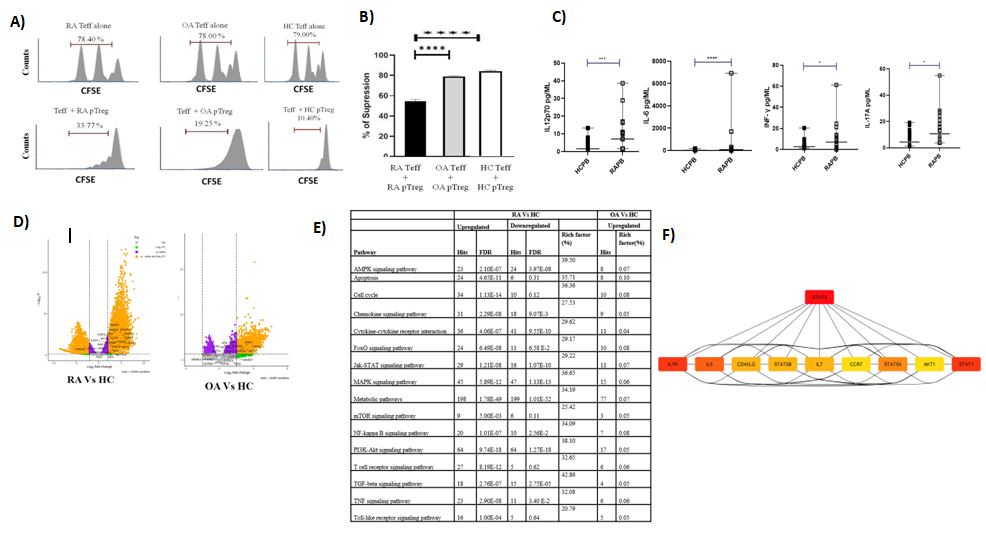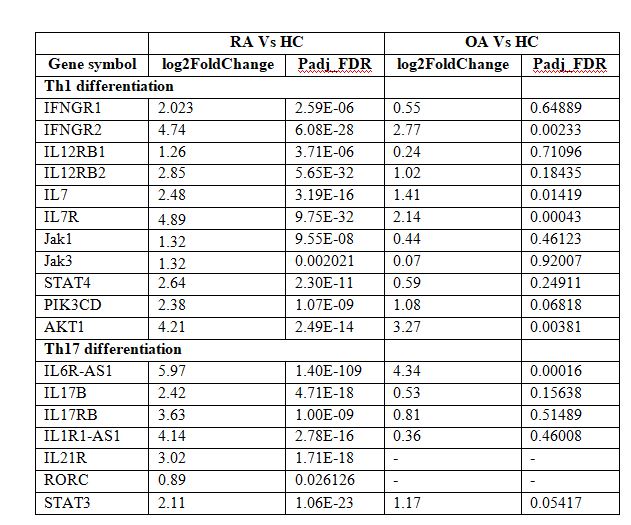Session Information
Date: Monday, November 18, 2024
Title: T Cell Biology & Targets in Autoimmune & Inflammatory Disease Poster
Session Type: Poster Session C
Session Time: 10:30AM-12:30PM
Background/Purpose: Inflammatory cytokines in the periphery can affect Treg stability and function by altering its molecular signatures. We aimed to characterize Treg phenotype, function and its transcriptome signatures in female, treatment-naïve Rheumatoid Arthritis (RA)
Methods: Treg, Th1-like, and Th17-like Treg frequencies and cytokine levels were quantified in peripheral blood (PB) of RA, Osteoarthritis (OA), and healthy controls (HC) (n=20 each) using fluorescent cytometry. RNA sequencing (n=3 per group) of Tregs was done using Illumina NovaSeq 6000. Differential gene expression was analyzed using DESeq2. Gene networks and hub genes were identified using Cytohubba
Results: Percentage of Tregs in RA was significantly lower than OA and HC. Tregs expressing CXCR3 (Th1-like Tregs) (p=0.001) and CCR6 (Th17-like Tregs) (p=0.001) were higher in RA compared to OA and HC(Table1). RA Tregs displayed reduced suppressive function compared to OA and HC (55.2% vs 79.2% vs 86.3%; (Figure1A&B). Cytokines IL-12, IL-6, IFN-γ and IL-17A were higher in RA compared to HC (Figure1C). Compared to HC, 12268 and 2728 genes were differentially expressed in RA and OA Tregs respectively (Figure1D). Specifically, expression of cytokine receptors, JAK-STAT signalling pathway and PI3/AKT signalling pathway genes were upregulated in RA (Table2, Figure1E). STAT3, AKT1, NFKB1 and STAT1 were identified as the top 10 hub-genes in RA Tregs (Figure1F).
Conclusion: Phenotypic analysis showed dysregulated Tregs and inflammatory cytokine levels and transcriptomic analysis revealed upregulation of cytokine-mediated JAK-STAT and PI3/AKT signalling pathways, likely promoting Treg trans-differentiation to Th-like Tregs. The potential to therapeutically target the identified hub genes warrants further research.
To cite this abstract in AMA style:
Kommoju V, Bulusu S, Vembar S, Kavadichanda C, Thabah M, Mariaselvam C, Negi V. Characterization of Treg Phenotype, Function and Its Transcriptome Signatures in Treatment-naïve Rheumatoid Arthritis [abstract]. Arthritis Rheumatol. 2024; 76 (suppl 9). https://acrabstracts.org/abstract/characterization-of-treg-phenotype-function-and-its-transcriptome-signatures-in-treatment-naive-rheumatoid-arthritis/. Accessed .« Back to ACR Convergence 2024
ACR Meeting Abstracts - https://acrabstracts.org/abstract/characterization-of-treg-phenotype-function-and-its-transcriptome-signatures-in-treatment-naive-rheumatoid-arthritis/



